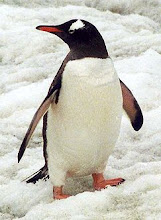Antarctic Penguins
Though penguins are assumed to be native to the South Pole, only four of the seventeen species have evolved the survival adaptations necessary to live and breed in the Antarctic year round. The physical features of the Adeline, Chinstrap, Gentoo, and Emperor penguins equip them to withstand the harshest living conditions in the world.
Besides these four species, there are a number of others, including the yellow heathered Macaroni penguin and the King penguin that visit the Antarctic regularly but migrate to warmer waters to breed. Penguins that live in Antarctica year round have a thermoregulation system and a survival sense that allows them to live comfortably both on the ice and in the water.
In the dark days of winter, when the Antarctic sees virtually no sunlight, the penguins that remain on the ice sheet sleep most of the day. To retain heat, penguins huddle in communities of up to 6,000 of their own species. When it's time to create a nest, most penguins build up a pile of rocks on top of the ice to place their eggs. The Emperor penguin, however, doesn't bother with a nest at all. The female Emperor lays just one egg and gives it to the male to protect while she goes off for weeks to feed. The male balances the egg on top of his feet, covering it with a small fold of skin called a brood patch. In the huddle, the male penguins rotate regularly so that none of the penguins have to stay on the outside of the circle exposed to the wind and cold for long periods of time. When it's time to take a turn on the outer edge of the pack, the penguins tuck their feathers in and shiver.
The movement provides enough warmth until they can head back into the inner core and rest in the warmth. In order to reduce the cold of the ice, penguins often put their weight on their heels and tails. Antarctic penguins also have complex nasal passages that prevent 80 percent of their heat from leaving the body. When the sun is out, the black dorsal plumage attracts its rays and penguins can stay warm enough to waddle or slide about alone.
Antarctic penguins spend about 75 percent of their lives in the water. A number of survival adaptations allow them to swim through water as cold as -2 degrees Celsius. In order to stay warm in these temperatures, penguins have to keep moving. Though penguins don't fly in the air, they are often said to fly through water. Instead of stopping each time they come up for air, they use a technique called "porpoising," in which they leap up for a quick breath while swiftly moving forward: Unlike most birds that have hollow bones for flight, penguins have evolved hard solid bones that keep them low in the water. Antarctic penguins also have unique feathers that work similarly to a waterproof diving suit. Tufts of down trap a layer of air within the feathers, preventing the water from penetrating the penguin's skin. The pressure of a deep dive releases this air, and a penguin has to rearrange the feathers through a process called"preening." Penguins also have an amazing circulatory system, which in extremely cold waters diverts blood from the flippers and legs to the heart.
While the harsh climate of the Antarctic doesn't threaten the survival of Antarctic penguins, overheating can be a concern, and therefore, global warming is a threat to them. Temperate species have certain physical features such as fewer feathers and less blubber to keep them cool on a hot day. African penguins have bald patches on their legs and face where excess heat can be released. The blood vessels in the penguin's skin dilate when the body begins to overheat, and the heat rises to the surface of the body. Penguins who are built for cold winters of the Antarctic have other survival.
วันอาทิตย์ที่ 8 กุมภาพันธ์ พ.ศ. 2552
สมัครสมาชิก:
ส่งความคิดเห็น (Atom)

ไม่มีความคิดเห็น:
แสดงความคิดเห็น